PyNarrative: A Python Library for Data Storytelling
0 likes46 views
PyNarrative is a Python library for data storytelling. More details here: https://github.com/pynarrative/pynarrative Install PyNarrative as follows: pip install pynarrative
1 of 21
Download to read offline



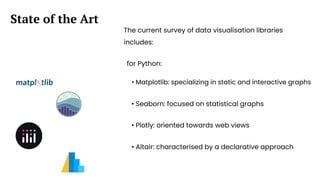

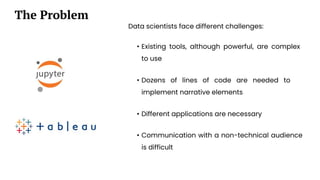
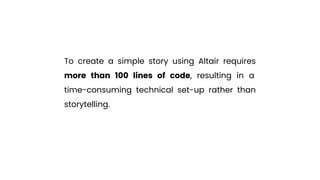




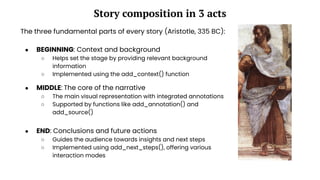









Recommended
Python for Data Science: A Comprehensive Guide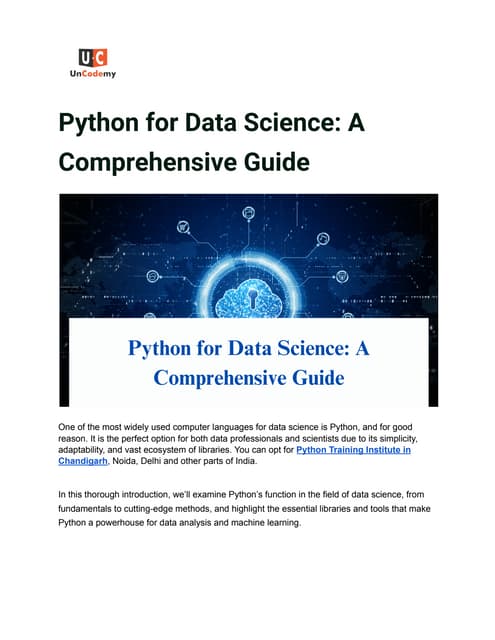



Python for Data Science: A Comprehensive Guidepriyanka rajput
╠²
PythonŌĆÖs popularity in data science is undeniable, to sum up. It is the best option for data analysts and scientists because of its simplicity, extensive library environment, and community support. The essential Python tools and best practices have been highlighted in this thorough book, enabling data aficionados to succeed in this fast-paced industry.
Matplotlib_Complete review_2021_abridged_version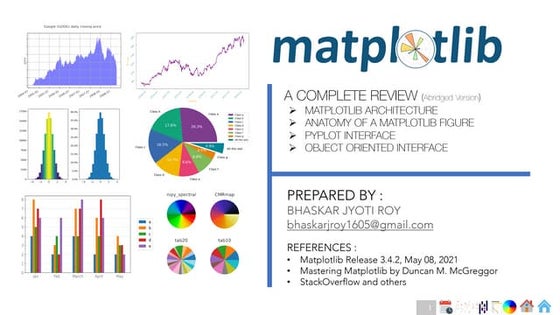



Matplotlib_Complete review_2021_abridged_versionBhaskar J.Roy
╠²
Majorly focused on Object Oriented way of plotting in Matplotlib, this review intends to serve as go to reference guide for quick plotting
#Matplotlib #Python #Pandas #SeabornMatplotlib Review 2021



Matplotlib Review 2021Bhaskar J.Roy
╠²
The document provides an overview of the Matplotlib library architecture and its key components. It discusses the three layers of Matplotlib - the backend layer, artist layer, and scripting layer. The backend layer handles rendering plots into different formats. The artist layer contains classes that generate visual elements. The scripting layer provides interfaces for users to access the other layers and generate figures and plots. It also outlines some common plot types and customization techniques in Matplotlib.C++



C++SamreenShaikh26
╠²
C++ is a multi-paradigm programming language created by Bjarne Stroustrup in 1983 that supports object-oriented programming. It is used to create general systems software, drivers, servers, and applications including video games. C++ supports the four main principles of OOP - abstraction, encapsulation, polymorphism, and inheritance - and uses classes to organize data structures and tie together data members and functions. The C++ standard library provides methods for manipulating files, strings, and template classes for data structures.Introduction to Analytics with Azure Notebooks and Python



Introduction to Analytics with Azure Notebooks and PythonJen Stirrup
╠²
Introduction to Analytics with Azure Notebooks and Python for Data Science and Business Intelligence. This is one part of a full day workshop on moving from BI to Analytics Bighead: AirbnbŌĆÖs End-to-End Machine Learning Platform with Krishna Puttaswa...



Bighead: AirbnbŌĆÖs End-to-End Machine Learning Platform with Krishna Puttaswa...Databricks
╠²
Bighead is Airbnb's machine learning infrastructure that was created to:
- Standardize and simplify the ML development workflow;
- Reduce the time and effort to build ML models from weeks/months to days/weeks; and
- Enable more teams at Airbnb to utilize ML.
It provides shared services and tools for data management, model training/inference, and model management to make the ML process more efficient and production-ready. This includes services like Zipline for feature storage, Redspot for notebook environments, Deep Thought for online inference, and the Bighead UI for model monitoring.AirBNB's ML platform - BigHead



AirBNB's ML platform - BigHeadKarthik Murugesan
╠²
Bighead is Airbnb's machine learning infrastructure that was created to:
1) Standardize and simplify the ML development workflow;
2) Reduce the time and effort to build ML models from weeks/months to days/weeks; and
3) Enable more teams at Airbnb to utilize ML.
It provides services for data management, model training/scoring, production deployment, and model management to make the ML process more efficient and consistent across teams. Bighead is built on open source technologies like Spark, TensorFlow, and Kubernetes but addresses gaps to fully support the end-to-end ML pipeline.Information technology Researhc Tools in IT



Information technology Researhc Tools in ITAhamedShibly
╠²
Information technology Researhc Tools in ITData Science decoded- author: Rohit Dubey



Data Science decoded- author: Rohit DubeyRohit Dubey
╠²
his book is designed for aspiring professionals
who have mastered the tools and
technologies of data scienceŌĆölike Python,
Machine Learning, Tableau, and moreŌĆöbut
sometimes struggle to articulate their
knowledge during interviews.
- Rohit Dubey (Author)
Why This Book
This book is your ultimate companion to
cracking data science interviews. It combines
technical mastery with strategic insights to
help you:
ŌĆó Master Core Skills: Learn Python, SQL,
machine learning, and data visualization
tailored for interview success.
ŌĆó Outsmart Interviewers: Get cunning, smart
answers to tackle tricky questions with
confidence.
ŌĆó Build Your Edge: Understand behavioral
tactics and communication hacks that
make you stand out.
ŌĆó Be Job-Ready: With case studies, practice
scenarios, and post-interview strategies, itŌĆÖs
all you need to land your dream role.Contents:
Topic of Interview | Page no.
Python Core | 2
Machine Learning | 17
Numpy | 28
Pandas | 38
Scikit | 47
Tesorflow | 60
Machine Learning Project-1 I 72
Machine Learning Project-2 I 89
Data Analytics | 103
Data Analytics project | 116
SQL | 125
SQL PROJECT | 137
MySQL | 150
MS Excel | 163
MS Excel Project | 175Contents
Topic of Interview | Page no.
R | 186
R Project | 193
Power BI | 202
Power BI Project | 213
Tableau | 226
Tableau Project | 235
mongo DB | 246
mongo DB Project | 256
BIG DATA | 263
BIG DATA Project | 271
Data Science | 281
Data Science Project | 291Presentation of the AIC-IMA publishing tool for OSCI



Presentation of the AIC-IMA publishing tool for OSCIRobert J. Stein
╠²
This document provides an overview of the design goals and technical approach for developing an online scholarly reader for catalogues. Key points include:
- The reader will be built using Drupal for content management, with a focus on flexible display layouts, support for different content types and media, and open collaboration.
- Content like sections, artworks, collectors, and footnotes will have customizable fields and be structured for online reading.
- The layout engine will compute flexible multi-column layouts based on font size and browser width.
- Users will be able to highlight, annotate and cite content. A services API will provide the reader application with content and navigation functionality.
- Future extensions may includeGetty Presentation of IMA/AIC OSCI tool



Getty Presentation of IMA/AIC OSCI toolRobert J. Stein
╠²
This document provides an overview of the design goals and technical approach for developing an online scholarly reader for catalogues. Key points include:
- The reader will be built using Drupal for content management, with a focus on flexible display layouts, support for different content types and media, and open collaboration.
- Content like sections, artworks, collectors, and footnotes will have customizable fields and be structured for online reading.
- The layout engine will compute flexible multi-column layouts based on font size and browser width.
- Navigation, content fetching, and figures will interface with Drupal through a REST API and services module.
- Additional features will include highlights, notes, citations,Python



PythonRural Engineering College Hulkoti
╠²
This Presentation Helps for the beginners to understand easily Python Programming Language, because i had given an snapshot of each concepts. Those who are knowing C,C++ and Java they can easily understand my presentation.How to Choose a Deep Learning Framework



How to Choose a Deep Learning FrameworkNavid Kalaei
╠²
The trend of neural networks has been attracted a huge community of researchers and practitioners. However, not all of the upfront runners are masters of deep learning and the colorful frameworks could be confusing, especially for the newcomers. In this presentation, I demystified the mystery of the leading frameworks of deep learning and provided a guideline on how to choose the most suitable option.Python Libraries Unveiled_ Empowering Data Science Explorations - Uncodemy.pdf



Python Libraries Unveiled_ Empowering Data Science Explorations - Uncodemy.pdfAhana Sharma
╠²
Explore the expansive realm of Python libraries, empowering data scientists with versatile tools and frameworks for comprehensive data explorations. Uncover the potential of these libraries in transforming data science endeavors with efficiency and innovation.A Modern Interface for Data Science on Postgres/Greenplum - Greenplum Summit ...



A Modern Interface for Data Science on Postgres/Greenplum - Greenplum Summit ...VMware Tanzu
╠²
This document discusses providing a modern interface for data science on Postgres and Greenplum databases. It introduces Ibis, a Python library that provides a DataFrame abstraction for SQL systems. Ibis allows defining complex data pipelines and transformations using deferred expressions, providing type checking before execution. The document argues that Ibis could be enhanced to support user-defined functions, saving results to tables, and data science modeling abstractions to provide a full-featured interface for data scientists on SQL databases.Python programming ppt.pptx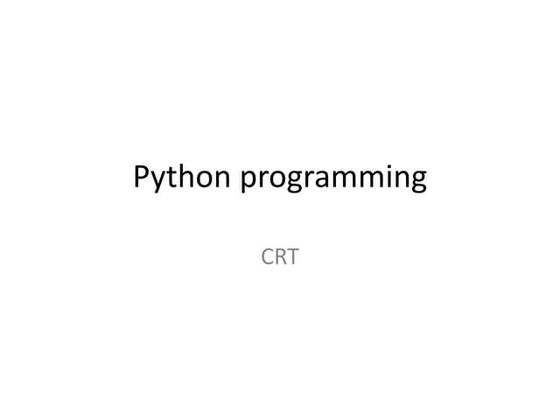



Python programming ppt.pptxnagendrasai12
╠²
Python is a versatile and widely-used high-level programming language known for its simplicity, readability, and extensive library support. Created by Guido van Rossum and first released in 1991, Python has since gained immense popularity across various domains, including web development, data science, scientific computing, artificial intelligence, and more. In this comprehensive description, we'll delve into Python's history, features, applications, and its vibrant community, highlighting why it continues to be a preferred choice for developers worldwide.
Table of Contents
Introduction to Python
Python's History and Evolution
Python's Key Features
3.1. Readability and Simplicity
3.2. High-level Language
3.3. Interpreted and Dynamic
3.4. Cross-platform Compatibility
3.5. Rich Standard Library
3.6. Community Support
Python's Application Domains
4.1. Web Development
4.2. Data Science and Machine Learning
4.3. Scientific Computing
4.4. Automation and Scripting
4.5. Game Development
4.6. Desktop Applications
Python Development Environments
5.1. IDLE
5.2. PyCharm
5.3. Jupyter Notebook
5.4. Visual Studio Code
Getting Started with Python
6.1. Installing Python
6.2. Your First Python Program
Python Syntax and Basic Concepts
7.1. Variables and Data Types
7.2. Conditional Statements
7.3. Loops
7.4. Functions
7.5. Exception Handling
Working with Python Libraries
8.1. NumPy
8.2. Pandas
8.3. Matplotlib
8.4. Scikit-Learn
Python and Web Development
9.1. Frameworks (Django, Flask)
9.2. Front-end Integration (HTML/CSS)
9.3. Database Interaction (SQL, NoSQL)
Python in Data Science
10.1. Data Analysis with Pandas
10.2. Data Visualization with Matplotlib and Seaborn
10.3. Machine Learning with Scikit-Learn
10.4. Deep Learning with TensorFlow and PyTorch
Scientific Computing with Python
11.1. Scientific Libraries (SciPy, SymPy)
11.2. Plotting and Visualization (Matplotlib)
Automation and Scripting
12.1. Automating Tasks
12.2. Scripting for System Administration
Game Development with Python
13.1. Pygame
13.2. Unity and Unreal Engine Integration
Desktop Applications with Python
14.1. Tkinter
14.2. PyQt
Python's Ecosystem and Package Management
Python Best Practices
16.1. Code Readability (PEP 8)
16.2. Documentation and Comments
16.3. Testing (Unit Testing, pytest)
16.4. Version Control (Git)
Python's Future and Trends
Conclusion
1. Introduction to Python
Python is a general-purpose, high-level programming language that was designed with a focus on code readability and simplicity. It uses an elegant and straightforward syntax that makes it easy for developers to express their ideas effectively, reducing the cost of program maintenance. Python's philosophy emphasizes the importance of code clarity and readability, which is encapsulated in the Zen of Python (PEP 20).
The language has gained immense popularity due to its versatility and a rich ecosystem of libraries and frameworks. Python is renowned for its vibrant community and extensive documentation, making it in pPython Mastery: A Comprehensive Guide to Setting Up Your Development Environment



Python Mastery: A Comprehensive Guide to Setting Up Your Development EnvironmentPython Devloper
╠²
**Module 1: Python Environment Setup Essentials**
Python, with its versatility and ease of use, has become a powerhouse in various domains, from web development to data science. Before diving into the fascinating world of Python programming, it's crucial to set up the right environment. This module serves as a comprehensive guide to ensure a seamless and efficient Python environment setup.
**1.1 Understanding Python Environments**
Python offers multiple environments to cater to diverse development needs. The choice between Python 2 and Python 3, as well as the decision between Anaconda and the standard Python distribution, depends on project requirements. This section provides a nuanced understanding of these options, enabling developers to make informed decisions.
**1.2 Installing Python**
The first step in setting up a Python environment is installing the interpreter. This module guides users through the installation process, whether on Windows, macOS, or Linux. It covers best practices, troubleshooting common installation issues, and ensuring a clean, stable Python installation.
**1.3 Virtual Environments**
Virtual environments are indispensable for managing dependencies and isolating project environments. This section explores the creation, activation, and deactivation of virtual environments using tools like `venv` or `virtualenv`. It emphasizes the importance of encapsulating project dependencies to avoid conflicts and ensure reproducibility.
**1.4 Package Management with pip**
The Python Package Index (PyPI) is a treasure trove of libraries and tools. Understanding how to use the `pip` package manager is crucial for installing, upgrading, and managing project dependencies. This section delves into pip commands, requirement files, and strategies for version management to maintain a stable and consistent development environment.
**1.5 Integrated Development Environments (IDEs)**
Choosing the right IDE can significantly enhance productivity. This module explores popular Python IDEs like PyCharm, VSCode, and Jupyter Notebooks. It covers installation, basic configuration, and features that cater to different development styles, whether it's web development, data science, or general-purpose coding.
**1.6 Version Control Integration**
Version control is a developer's best friend. This section demonstrates how to integrate Python projects with version control systems like Git. From initializing a repository to committing changes and collaborating with a team, developers learn essential version control practices to streamline their workflow.
**1.7 Configuration and Customization**
Tailoring the Python environment to individual preferences is an often-overlooked aspect of setup. This part of the module covers customizing the Python shell, configuring environment variables, and optimizing settings in IDEs. A personalized environment can significantly enhance the development experience.
**1.8 Troubleshooting and Common Pitfalls**
No sSubstrait Overview.pdf



Substrait Overview.pdfRinat Abdullin
╠²
Substrait is a cross-language serialization format for relational algebra plans that aims to allow data computation engines and analysis tools to work together across programming languages. It defines common types, functions, and relational operators that multiple projects can reuse. Substrait plans are self-contained and serializable, with the goal of enabling innovation in frontend and backend systems independently. Several companies are actively working on integrations and the project is governed openly on GitHub.Why to Choose Python for Data Science Master.pptx



Why to Choose Python for Data Science Master.pptxHGLLearn
╠²
HGL Learn is one of the Machine Learning in Hyderabad. We are providing professional educational services SAP training, Dotnet, Java, DevOps, Hadoop, Salesforce, Python, Core Java and other courses offered with a job orientation.PYTHON UNIT 1



PYTHON UNIT 1nagendrasai12
╠²
Certainly! Here's a detailed 3000-word description of Python:
# Python: A Comprehensive Overview
Python is a high-level, versatile, and dynamically-typed programming language known for its simplicity and readability. Created by Guido van Rossum in the late 1980s, Python has since become one of the most popular programming languages worldwide. In this comprehensive overview, we will delve into the key aspects of Python, from its history and design philosophy to its syntax, libraries, and real-world applications.
## **History and Evolution of Python**
Python's history dates back to December 1989 when Guido van Rossum, a Dutch programmer, began working on it as a side project during his Christmas holidays. His aim was to create a language that emphasized code readability and allowed developers to express their ideas in fewer lines of code compared to other languages like C++ or Perl.
The first official Python release, Python 0.9.0, was released in February 1991. Python's name was inspired by Guido's love for the British comedy group Monty Python. Despite its humorous origins, Python quickly gained popularity in the software development community.
Python's major versions include Python 1.0 (1994), Python 2.0 (2000), Python 3.0 (2008), and the subsequent 3.x releases. The transition from Python 2 to Python 3 was a significant milestone in Python's history, as it involved breaking compatibility with Python 2 to introduce improvements and address some language inconsistencies. Python 2 reached its end of life on January 1, 2020, and Python 3 is now the standard and recommended version for new projects.
## **Design Philosophy: The Zen of Python**
Python's success can be attributed, in part, to its clear and guiding design principles, often referred to as "The Zen of Python" or "PEP 20" (Python Enhancement Proposal 20). These principles encapsulate the language's philosophy and provide a framework for writing clean, readable, and maintainable code. Some notable principles from "The Zen of Python" include:
- **Readability Counts:** Code should be easy to read and understand. Python's syntax enforces this with its use of indentation for block structure.
- **Simple is Better Than Complex:** Python encourages simplicity in both code design and implementation. It favors straightforward solutions over convoluted ones.
- **Explicit is Better Than Implicit:** Code should be explicit and not rely on hidden or magical behavior. This principle promotes code clarity and predictability.
- **There Should Be One-- and Preferably Only One --Obvious Way to Do It:** Python aims to provide a single, clear way to perform a specific task to reduce confusion and make code more consistent.
- **Errors Should Never Pass Silently:** Python encourages robust error handling and reporting to help developers identify and fix issues promptly.
## **Python Syntax and Language Features**
Python's syntax is known for its simplicity and readability. Here are some key languagUntitled document (12).pdf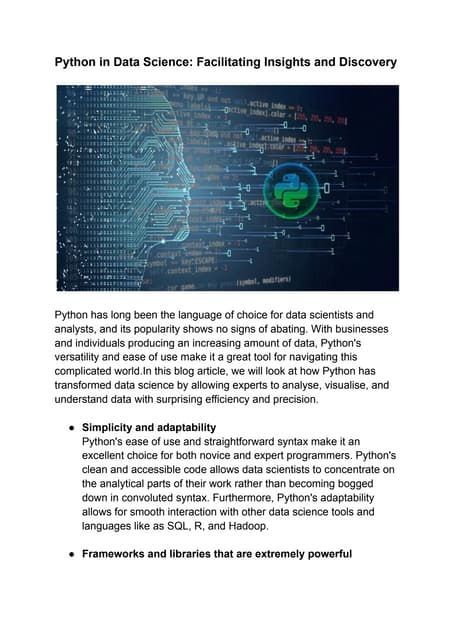



Untitled document (12).pdfcollinscafe
╠²
Python has long been the language of choice for data scientists and analysts, and its popularity shows no signs of abating. With businesses and individuals producing an increasing amount of data, Python's versatility and ease of use make it a great tool for navigating this complicated world.In this blog article, we will look at how Python has transformed data science by allowing experts to analyse, visualise, and understand data with surprising efficiency and precision.
intro to python.pptx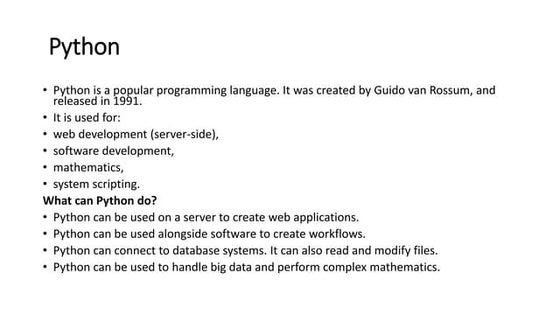



intro to python.pptxUpasnaSharma37
╠²
Python is a popular programming language created in 1991 by Guido van Rossum. It can be used for web development, software development, mathematics, and system scripting. Python code can be executed immediately as it is written due to its interpreter system, allowing for quick prototyping. It works across different platforms and has a simple, English-like syntax. Common data types in Python include numeric, string, list, and tuple types.Big data berlin



Big data berlinkammeyer
╠²
This document provides an agenda and overview of a talk on big data and data science given by Peter Wang. The key points covered include:
- An honest perspective on big data trends and challenges over time.
- Architecting systems for data exploration and analysis using tools like Continuum Analytics' Blaze and Numba libraries.
- Python's role in data science for its ecosystem of libraries and accessibility to domain experts.2015 bioinformatics python_introduction_wim_vancriekinge_vfinal



2015 bioinformatics python_introduction_wim_vancriekinge_vfinalProf. Wim Van Criekinge
╠²
The document provides an overview of using Python for bioinformatics, discussing what Python is, why it is useful for bioinformatics, how to set up Python in integrated development environments like Eclipse with PyDev, how to share code using Git and GitHub, and includes examples of Hello World and bioinformatics programs in Python. It introduces Python and argues it is well-suited for bioinformatics due to its extensive standard libraries, ease of use, and wide adoption in science. The document demonstrates how to install Python, set up an IDE, create and run simple Python programs, and use version control with Git and GitHub to collaborate on projects.Presentation.pptx



Presentation.pptxAyushmanTiwari11
╠²
This document is a report on Python for a class. It includes sections on the history of Python, why it is a good choice for learning programming, its core characteristics like being interpreted and object-oriented, common data structures like lists and dictionaries, the NumPy package for scientific computing, and a conclusion about the benefits of using Python as a teaching language.Presentation.pptx



Presentation.pptxAyushmanTiwari11
╠²
This document is a report on Python for a class. It includes sections on the history of Python, why it is a good choice for learning programming, its core characteristics like being interpreted and object-oriented, common data structures like lists and dictionaries, the NumPy package for scientific computing, and a conclusion about the benefits of using Python as a teaching language.An Empirical Study to Use Large Language Models to Extract Named Entities fro...



An Empirical Study to Use Large Language Models to Extract Named Entities fro...Angelica Lo Duca
╠²
Abstract: Large language models (LLMs) are a very recent technology that assists researchers, developers, and people in general to complete their tasks quickly. The main difficulty in using this technology is defining effective instructions for the models, understanding the modelsŌĆÖ behavior, and evaluating the correctness of the produced results. This paper describes a possible approach based on LLMs to extract named entities from repetitive texts, such as population registries. The paper focuses on two LLMs (GPT 3.5 Turbo and GPT 4), and runs some empirical experiments based on different levels of detail contained in the instructions. Results show that the best performance is achieved with GPT 4, with a high level of detail in the instructions and the highest costs. The trade-off between costs and performance is given when using GPT 3.5 Turbo when the level of detail is medium.
https://www.scitepress.org/PublicationsDetail.aspx?ID=AJ1Gr6pWvwg=&t=1Data Storytelling with Altair and AI - Chapter 1.pdf



Data Storytelling with Altair and AI - Chapter 1.pdfAngelica Lo Duca
╠²
An overview of Chapter 1 of the book Data Storytelling with Altair and AI
What is Data Storytelling?
Data storytelling goes beyond visualization. ItŌĆÖs a journey that starts with data exploration and culminates in a narrative that guides the audience toward insights and understanding. This approach bridges the gap between data professionals and audiences by framing data in a meaningful context.
Learn more
Amazon
https://www.amazon.com/Data-Storytelling-Altair-Angelica-Duca/dp/1633437922/
Manning.com
https://www.manning.com/books/data-storytelling-with-altair-and-ai More Related Content
Similar to PyNarrative: A Python Library for Data Storytelling (20)
Information technology Researhc Tools in IT



Information technology Researhc Tools in ITAhamedShibly
╠²
Information technology Researhc Tools in ITData Science decoded- author: Rohit Dubey



Data Science decoded- author: Rohit DubeyRohit Dubey
╠²
his book is designed for aspiring professionals
who have mastered the tools and
technologies of data scienceŌĆölike Python,
Machine Learning, Tableau, and moreŌĆöbut
sometimes struggle to articulate their
knowledge during interviews.
- Rohit Dubey (Author)
Why This Book
This book is your ultimate companion to
cracking data science interviews. It combines
technical mastery with strategic insights to
help you:
ŌĆó Master Core Skills: Learn Python, SQL,
machine learning, and data visualization
tailored for interview success.
ŌĆó Outsmart Interviewers: Get cunning, smart
answers to tackle tricky questions with
confidence.
ŌĆó Build Your Edge: Understand behavioral
tactics and communication hacks that
make you stand out.
ŌĆó Be Job-Ready: With case studies, practice
scenarios, and post-interview strategies, itŌĆÖs
all you need to land your dream role.Contents:
Topic of Interview | Page no.
Python Core | 2
Machine Learning | 17
Numpy | 28
Pandas | 38
Scikit | 47
Tesorflow | 60
Machine Learning Project-1 I 72
Machine Learning Project-2 I 89
Data Analytics | 103
Data Analytics project | 116
SQL | 125
SQL PROJECT | 137
MySQL | 150
MS Excel | 163
MS Excel Project | 175Contents
Topic of Interview | Page no.
R | 186
R Project | 193
Power BI | 202
Power BI Project | 213
Tableau | 226
Tableau Project | 235
mongo DB | 246
mongo DB Project | 256
BIG DATA | 263
BIG DATA Project | 271
Data Science | 281
Data Science Project | 291Presentation of the AIC-IMA publishing tool for OSCI



Presentation of the AIC-IMA publishing tool for OSCIRobert J. Stein
╠²
This document provides an overview of the design goals and technical approach for developing an online scholarly reader for catalogues. Key points include:
- The reader will be built using Drupal for content management, with a focus on flexible display layouts, support for different content types and media, and open collaboration.
- Content like sections, artworks, collectors, and footnotes will have customizable fields and be structured for online reading.
- The layout engine will compute flexible multi-column layouts based on font size and browser width.
- Users will be able to highlight, annotate and cite content. A services API will provide the reader application with content and navigation functionality.
- Future extensions may includeGetty Presentation of IMA/AIC OSCI tool



Getty Presentation of IMA/AIC OSCI toolRobert J. Stein
╠²
This document provides an overview of the design goals and technical approach for developing an online scholarly reader for catalogues. Key points include:
- The reader will be built using Drupal for content management, with a focus on flexible display layouts, support for different content types and media, and open collaboration.
- Content like sections, artworks, collectors, and footnotes will have customizable fields and be structured for online reading.
- The layout engine will compute flexible multi-column layouts based on font size and browser width.
- Navigation, content fetching, and figures will interface with Drupal through a REST API and services module.
- Additional features will include highlights, notes, citations,Python



PythonRural Engineering College Hulkoti
╠²
This Presentation Helps for the beginners to understand easily Python Programming Language, because i had given an snapshot of each concepts. Those who are knowing C,C++ and Java they can easily understand my presentation.How to Choose a Deep Learning Framework



How to Choose a Deep Learning FrameworkNavid Kalaei
╠²
The trend of neural networks has been attracted a huge community of researchers and practitioners. However, not all of the upfront runners are masters of deep learning and the colorful frameworks could be confusing, especially for the newcomers. In this presentation, I demystified the mystery of the leading frameworks of deep learning and provided a guideline on how to choose the most suitable option.Python Libraries Unveiled_ Empowering Data Science Explorations - Uncodemy.pdf



Python Libraries Unveiled_ Empowering Data Science Explorations - Uncodemy.pdfAhana Sharma
╠²
Explore the expansive realm of Python libraries, empowering data scientists with versatile tools and frameworks for comprehensive data explorations. Uncover the potential of these libraries in transforming data science endeavors with efficiency and innovation.A Modern Interface for Data Science on Postgres/Greenplum - Greenplum Summit ...



A Modern Interface for Data Science on Postgres/Greenplum - Greenplum Summit ...VMware Tanzu
╠²
This document discusses providing a modern interface for data science on Postgres and Greenplum databases. It introduces Ibis, a Python library that provides a DataFrame abstraction for SQL systems. Ibis allows defining complex data pipelines and transformations using deferred expressions, providing type checking before execution. The document argues that Ibis could be enhanced to support user-defined functions, saving results to tables, and data science modeling abstractions to provide a full-featured interface for data scientists on SQL databases.Python programming ppt.pptx



Python programming ppt.pptxnagendrasai12
╠²
Python is a versatile and widely-used high-level programming language known for its simplicity, readability, and extensive library support. Created by Guido van Rossum and first released in 1991, Python has since gained immense popularity across various domains, including web development, data science, scientific computing, artificial intelligence, and more. In this comprehensive description, we'll delve into Python's history, features, applications, and its vibrant community, highlighting why it continues to be a preferred choice for developers worldwide.
Table of Contents
Introduction to Python
Python's History and Evolution
Python's Key Features
3.1. Readability and Simplicity
3.2. High-level Language
3.3. Interpreted and Dynamic
3.4. Cross-platform Compatibility
3.5. Rich Standard Library
3.6. Community Support
Python's Application Domains
4.1. Web Development
4.2. Data Science and Machine Learning
4.3. Scientific Computing
4.4. Automation and Scripting
4.5. Game Development
4.6. Desktop Applications
Python Development Environments
5.1. IDLE
5.2. PyCharm
5.3. Jupyter Notebook
5.4. Visual Studio Code
Getting Started with Python
6.1. Installing Python
6.2. Your First Python Program
Python Syntax and Basic Concepts
7.1. Variables and Data Types
7.2. Conditional Statements
7.3. Loops
7.4. Functions
7.5. Exception Handling
Working with Python Libraries
8.1. NumPy
8.2. Pandas
8.3. Matplotlib
8.4. Scikit-Learn
Python and Web Development
9.1. Frameworks (Django, Flask)
9.2. Front-end Integration (HTML/CSS)
9.3. Database Interaction (SQL, NoSQL)
Python in Data Science
10.1. Data Analysis with Pandas
10.2. Data Visualization with Matplotlib and Seaborn
10.3. Machine Learning with Scikit-Learn
10.4. Deep Learning with TensorFlow and PyTorch
Scientific Computing with Python
11.1. Scientific Libraries (SciPy, SymPy)
11.2. Plotting and Visualization (Matplotlib)
Automation and Scripting
12.1. Automating Tasks
12.2. Scripting for System Administration
Game Development with Python
13.1. Pygame
13.2. Unity and Unreal Engine Integration
Desktop Applications with Python
14.1. Tkinter
14.2. PyQt
Python's Ecosystem and Package Management
Python Best Practices
16.1. Code Readability (PEP 8)
16.2. Documentation and Comments
16.3. Testing (Unit Testing, pytest)
16.4. Version Control (Git)
Python's Future and Trends
Conclusion
1. Introduction to Python
Python is a general-purpose, high-level programming language that was designed with a focus on code readability and simplicity. It uses an elegant and straightforward syntax that makes it easy for developers to express their ideas effectively, reducing the cost of program maintenance. Python's philosophy emphasizes the importance of code clarity and readability, which is encapsulated in the Zen of Python (PEP 20).
The language has gained immense popularity due to its versatility and a rich ecosystem of libraries and frameworks. Python is renowned for its vibrant community and extensive documentation, making it in pPython Mastery: A Comprehensive Guide to Setting Up Your Development Environment



Python Mastery: A Comprehensive Guide to Setting Up Your Development EnvironmentPython Devloper
╠²
**Module 1: Python Environment Setup Essentials**
Python, with its versatility and ease of use, has become a powerhouse in various domains, from web development to data science. Before diving into the fascinating world of Python programming, it's crucial to set up the right environment. This module serves as a comprehensive guide to ensure a seamless and efficient Python environment setup.
**1.1 Understanding Python Environments**
Python offers multiple environments to cater to diverse development needs. The choice between Python 2 and Python 3, as well as the decision between Anaconda and the standard Python distribution, depends on project requirements. This section provides a nuanced understanding of these options, enabling developers to make informed decisions.
**1.2 Installing Python**
The first step in setting up a Python environment is installing the interpreter. This module guides users through the installation process, whether on Windows, macOS, or Linux. It covers best practices, troubleshooting common installation issues, and ensuring a clean, stable Python installation.
**1.3 Virtual Environments**
Virtual environments are indispensable for managing dependencies and isolating project environments. This section explores the creation, activation, and deactivation of virtual environments using tools like `venv` or `virtualenv`. It emphasizes the importance of encapsulating project dependencies to avoid conflicts and ensure reproducibility.
**1.4 Package Management with pip**
The Python Package Index (PyPI) is a treasure trove of libraries and tools. Understanding how to use the `pip` package manager is crucial for installing, upgrading, and managing project dependencies. This section delves into pip commands, requirement files, and strategies for version management to maintain a stable and consistent development environment.
**1.5 Integrated Development Environments (IDEs)**
Choosing the right IDE can significantly enhance productivity. This module explores popular Python IDEs like PyCharm, VSCode, and Jupyter Notebooks. It covers installation, basic configuration, and features that cater to different development styles, whether it's web development, data science, or general-purpose coding.
**1.6 Version Control Integration**
Version control is a developer's best friend. This section demonstrates how to integrate Python projects with version control systems like Git. From initializing a repository to committing changes and collaborating with a team, developers learn essential version control practices to streamline their workflow.
**1.7 Configuration and Customization**
Tailoring the Python environment to individual preferences is an often-overlooked aspect of setup. This part of the module covers customizing the Python shell, configuring environment variables, and optimizing settings in IDEs. A personalized environment can significantly enhance the development experience.
**1.8 Troubleshooting and Common Pitfalls**
No sSubstrait Overview.pdf



Substrait Overview.pdfRinat Abdullin
╠²
Substrait is a cross-language serialization format for relational algebra plans that aims to allow data computation engines and analysis tools to work together across programming languages. It defines common types, functions, and relational operators that multiple projects can reuse. Substrait plans are self-contained and serializable, with the goal of enabling innovation in frontend and backend systems independently. Several companies are actively working on integrations and the project is governed openly on GitHub.Why to Choose Python for Data Science Master.pptx



Why to Choose Python for Data Science Master.pptxHGLLearn
╠²
HGL Learn is one of the Machine Learning in Hyderabad. We are providing professional educational services SAP training, Dotnet, Java, DevOps, Hadoop, Salesforce, Python, Core Java and other courses offered with a job orientation.PYTHON UNIT 1



PYTHON UNIT 1nagendrasai12
╠²
Certainly! Here's a detailed 3000-word description of Python:
# Python: A Comprehensive Overview
Python is a high-level, versatile, and dynamically-typed programming language known for its simplicity and readability. Created by Guido van Rossum in the late 1980s, Python has since become one of the most popular programming languages worldwide. In this comprehensive overview, we will delve into the key aspects of Python, from its history and design philosophy to its syntax, libraries, and real-world applications.
## **History and Evolution of Python**
Python's history dates back to December 1989 when Guido van Rossum, a Dutch programmer, began working on it as a side project during his Christmas holidays. His aim was to create a language that emphasized code readability and allowed developers to express their ideas in fewer lines of code compared to other languages like C++ or Perl.
The first official Python release, Python 0.9.0, was released in February 1991. Python's name was inspired by Guido's love for the British comedy group Monty Python. Despite its humorous origins, Python quickly gained popularity in the software development community.
Python's major versions include Python 1.0 (1994), Python 2.0 (2000), Python 3.0 (2008), and the subsequent 3.x releases. The transition from Python 2 to Python 3 was a significant milestone in Python's history, as it involved breaking compatibility with Python 2 to introduce improvements and address some language inconsistencies. Python 2 reached its end of life on January 1, 2020, and Python 3 is now the standard and recommended version for new projects.
## **Design Philosophy: The Zen of Python**
Python's success can be attributed, in part, to its clear and guiding design principles, often referred to as "The Zen of Python" or "PEP 20" (Python Enhancement Proposal 20). These principles encapsulate the language's philosophy and provide a framework for writing clean, readable, and maintainable code. Some notable principles from "The Zen of Python" include:
- **Readability Counts:** Code should be easy to read and understand. Python's syntax enforces this with its use of indentation for block structure.
- **Simple is Better Than Complex:** Python encourages simplicity in both code design and implementation. It favors straightforward solutions over convoluted ones.
- **Explicit is Better Than Implicit:** Code should be explicit and not rely on hidden or magical behavior. This principle promotes code clarity and predictability.
- **There Should Be One-- and Preferably Only One --Obvious Way to Do It:** Python aims to provide a single, clear way to perform a specific task to reduce confusion and make code more consistent.
- **Errors Should Never Pass Silently:** Python encourages robust error handling and reporting to help developers identify and fix issues promptly.
## **Python Syntax and Language Features**
Python's syntax is known for its simplicity and readability. Here are some key languagUntitled document (12).pdf



Untitled document (12).pdfcollinscafe
╠²
Python has long been the language of choice for data scientists and analysts, and its popularity shows no signs of abating. With businesses and individuals producing an increasing amount of data, Python's versatility and ease of use make it a great tool for navigating this complicated world.In this blog article, we will look at how Python has transformed data science by allowing experts to analyse, visualise, and understand data with surprising efficiency and precision.
intro to python.pptx



intro to python.pptxUpasnaSharma37
╠²
Python is a popular programming language created in 1991 by Guido van Rossum. It can be used for web development, software development, mathematics, and system scripting. Python code can be executed immediately as it is written due to its interpreter system, allowing for quick prototyping. It works across different platforms and has a simple, English-like syntax. Common data types in Python include numeric, string, list, and tuple types.Big data berlin



Big data berlinkammeyer
╠²
This document provides an agenda and overview of a talk on big data and data science given by Peter Wang. The key points covered include:
- An honest perspective on big data trends and challenges over time.
- Architecting systems for data exploration and analysis using tools like Continuum Analytics' Blaze and Numba libraries.
- Python's role in data science for its ecosystem of libraries and accessibility to domain experts.2015 bioinformatics python_introduction_wim_vancriekinge_vfinal



2015 bioinformatics python_introduction_wim_vancriekinge_vfinalProf. Wim Van Criekinge
╠²
The document provides an overview of using Python for bioinformatics, discussing what Python is, why it is useful for bioinformatics, how to set up Python in integrated development environments like Eclipse with PyDev, how to share code using Git and GitHub, and includes examples of Hello World and bioinformatics programs in Python. It introduces Python and argues it is well-suited for bioinformatics due to its extensive standard libraries, ease of use, and wide adoption in science. The document demonstrates how to install Python, set up an IDE, create and run simple Python programs, and use version control with Git and GitHub to collaborate on projects.Presentation.pptx



Presentation.pptxAyushmanTiwari11
╠²
This document is a report on Python for a class. It includes sections on the history of Python, why it is a good choice for learning programming, its core characteristics like being interpreted and object-oriented, common data structures like lists and dictionaries, the NumPy package for scientific computing, and a conclusion about the benefits of using Python as a teaching language.Presentation.pptx



Presentation.pptxAyushmanTiwari11
╠²
This document is a report on Python for a class. It includes sections on the history of Python, why it is a good choice for learning programming, its core characteristics like being interpreted and object-oriented, common data structures like lists and dictionaries, the NumPy package for scientific computing, and a conclusion about the benefits of using Python as a teaching language.More from Angelica Lo Duca (10)
An Empirical Study to Use Large Language Models to Extract Named Entities fro...



An Empirical Study to Use Large Language Models to Extract Named Entities fro...Angelica Lo Duca
╠²
Abstract: Large language models (LLMs) are a very recent technology that assists researchers, developers, and people in general to complete their tasks quickly. The main difficulty in using this technology is defining effective instructions for the models, understanding the modelsŌĆÖ behavior, and evaluating the correctness of the produced results. This paper describes a possible approach based on LLMs to extract named entities from repetitive texts, such as population registries. The paper focuses on two LLMs (GPT 3.5 Turbo and GPT 4), and runs some empirical experiments based on different levels of detail contained in the instructions. Results show that the best performance is achieved with GPT 4, with a high level of detail in the instructions and the highest costs. The trade-off between costs and performance is given when using GPT 3.5 Turbo when the level of detail is medium.
https://www.scitepress.org/PublicationsDetail.aspx?ID=AJ1Gr6pWvwg=&t=1Data Storytelling with Altair and AI - Chapter 1.pdf



Data Storytelling with Altair and AI - Chapter 1.pdfAngelica Lo Duca
╠²
An overview of Chapter 1 of the book Data Storytelling with Altair and AI
What is Data Storytelling?
Data storytelling goes beyond visualization. ItŌĆÖs a journey that starts with data exploration and culminates in a narrative that guides the audience toward insights and understanding. This approach bridges the gap between data professionals and audiences by framing data in a meaningful context.
Learn more
Amazon
https://www.amazon.com/Data-Storytelling-Altair-Angelica-Duca/dp/1633437922/
Manning.com
https://www.manning.com/books/data-storytelling-with-altair-and-ai Towards a Framework for AI-Assisted Data Storytelling



Towards a Framework for AI-Assisted Data StorytellingAngelica Lo Duca
╠²
Data storytelling is building stories supported by data to engage the audience and inspire them to make decisions. Applying data storytelling to data visualization means adding a narrative that better explains the visual and engages the audience. Generative AI can help transform data visuals into data stories. This paper proposes AI-DaSt (AI-based Data Storytelling), a framework that helps build data stories based on generative AI. The framework focuses on visual charts and incorporates two main generative AI models provided by the OpenAI APIs: text generation and image generation. We use GPT-3.5 for the chart title, commentary and notes, and image generation for images to include in the chart. We also describe the potential ethical issues and possible countermeasures related to using Generative AI in data storytelling. Finally, we focus on a practical use case, which shows how to transform a data visualization chart into a data story using the implemented framework.Data Storytelling with the DIKW Pyramid.pdf



Data Storytelling with the DIKW Pyramid.pdfAngelica Lo Duca
╠²
Data storytelling is building stories
supported by data, allowing analysts and data scientists to present and share their insights to engage the audience and inspire them to make decisions.
In these slides you'll learn how to use the DIKW pyramid to turn your data visualization chart into a data story. 3 Strategies to Organize your Data Science Projects.pdf



3 Strategies to Organize your Data Science Projects.pdfAngelica Lo Duca
╠²
Having trouble figuring out the best way to organize your data science projects?
Check out these strategies for efficient planning and manual installation, Cookiecutter, or utilizing a cloud service ¤żō ¤Æ╗ #datascience #organization
Link to the full article: https://towardsdatascience.com/how-to-organize-your-data-science-project-3710a476bf8cHow to organize your data science project with Comet.pdf



How to organize your data science project with Comet.pdfAngelica Lo Duca
╠²
In this slides, we address the common challenges faced by data science practitioners, students, and aspiring data scientists when it comes to project management. We understand the difficulties of keeping track of experiments, managing code, and collaborating effectively.
But fret not! We introduce you to Comet, the ultimate solution for organizing data science projects. Join us as we explore the features and benefits of Comet and how it can transform your workflow, boost collaboration, and unleash your full potential as a data scientist.
Buy now the book
Comet for Data Science
http://www.cometfordatascience.com/order.htmlA deep dive into neuton



A deep dive into neutonAngelica Lo Duca
╠²
An overview of the platform, its capabilities and an example of usage.
https://towardsdatascience.com/a-deep-dive-into-neuton-dab72db4b2d0Relational vs Non Relational Databases



Relational vs Non Relational DatabasesAngelica Lo Duca
╠²
The document compares relational and non-relational databases. Relational databases organize data into tables with rows and columns and use SQL for queries. They are good for structured data but difficult to change. Non-relational databases have flexible schemas and adapt easily but can be less reliable. Examples of relational databases include MySQL and SQL Server, while non-relational options include MongoDB, Cassandra, and Redis.How to model digital objects within the semantic web



How to model digital objects within the semantic webAngelica Lo Duca
╠²
These slides describe the general concept of semantic Web and Linked Data, then they illustrate the concept of digital object. Finally they give a use case.Linked Data



Linked DataAngelica Lo Duca
╠²
This document discusses best practices for publishing linked data on the semantic web. It covers key topics such as using URIs to identify things, following the four principles of linked data, establishing links within and across datasets, choosing appropriate vocabularies, adding metadata about datasets and licenses, testing and debugging the data, and achieving higher levels of the five star model of linked open data. The overall goal is to connect and integrate structured data on the web in a way that is discoverable and reusable.Recently uploaded (20)
FinanceGPT Labs Whitepaper - Risks of Large Quantitative Models in Financial ...



FinanceGPT Labs Whitepaper - Risks of Large Quantitative Models in Financial ...FinanceGPT Labs
╠²
Large Quantitative Models (LQMs) are a class of generative AI models designed for quantitative analysis in finance. This whitepaper explores the unique risks LQMs pose to financial markets, focusing on vulnerabilities to data poisoning attacks. These attacks can manipulate model outputs, leading to flawed economic forecasts and market instability. The whitepaper also addresses systemic risks like herding behavior and the potential for cascading failures due to the interconnectedness of financial institutions. Effective mitigation strategies, including robust data validation, adversarial training, real-time monitoring, and secure model development lifecycles, are discussed. The analysis emphasizes the need for proactive cybersecurity measures and regulatory frameworks to ensure the responsible and secure deployment of LQMs, maintaining the stability and integrity of financial markets.Predicting-Training-Needs-with-Machine-Learning.pptx



Predicting-Training-Needs-with-Machine-Learning.pptxAccess Business Management Conferencing International
╠²
research explores the application of machine learning to predict common training areas and client needs in East Africa's dynamic labor market. By leveraging historical data, industry trends, and advanced algorithms, the study aims to revolutionize how training programs are designed and deliveredHow can Competitive Intelligence Platforms benefit a Business?



How can Competitive Intelligence Platforms benefit a Business?Contify
╠²
Competitive intelligence platforms help businesses stay ahead by analyzing market trends, tracking competitors, and identifying growth opportunities. They provide real-time insights, improving decision-making and strategic planning. With data-driven analysis, businesses can optimize marketing, enhance product development, and gain a competitive edge, ensuring long-term success in a dynamic market.
For more information please visit here https://www.contify.com/platform/Know Your Nation In Numbers myIndia-2006



Know Your Nation In Numbers myIndia-2006sahimbarc
╠²
Know Your Nation In Numbers , in nutshell.
Facts and Figures about India in 2006 : History/Geography, Society, Polity, Economy and MiscellaneousOrange County Tableau User Group 2025 Late Q1 2025-03-23.pdf



Orange County Tableau User Group 2025 Late Q1 2025-03-23.pdfgemmajfrancisco
╠²
Orange County Tableau User Group's late Q1 2025 meeting (2025-03-23)OPPOTUS - Malaysias on Malaysia 4Q2024.pdf



OPPOTUS - Malaysias on Malaysia 4Q2024.pdfOppotus
╠²
Key things you need to know on Malaysian consumer confidence, key behavioral, tech, e-wallet & crypto trends in Malaysia. buiding web based land registration buiding web based land registration and m...



buiding web based land registration buiding web based land registration and m...habtamudele9
╠²
buiding web based land registration and management systemSelzy: Simplifying Email Marketing for Maximum Growth



Selzy: Simplifying Email Marketing for Maximum GrowthSelzy
╠²
This presentation is about Selzy, an easy-to-use and affordable email marketing tool that helps businesses create and launch effective email campaigns with minimal effort. It highlights the challenges of traditional email marketing, showcases SelzyŌĆÖs AI-powered email builder, fast setup, and 24/7 support, and demonstrates the toolŌĆÖs impact through user growth and market potential. With a strong ROI and a rapidly expanding customer base, Selzy positions itself as a powerful yet simple solution for businesses looking to boost engagement and sales through email marketing.Agile Infinity: When the Customer Is an Abstract Concept



Agile Infinity: When the Customer Is an Abstract ConceptLoic Merckel
╠²
ØŚ¬ØŚĄØŚ▓ØŚ╗ ØśüØŚĄØŚ▓ ØŚ¢ØśéØśĆØśüØŚ╝ØŚ║ØŚ▓ØŚ┐ ØŚĢØŚ▓ØŚ░ØŚ╝ØŚ║ØŚ▓ØśĆ ØŚ«ØŚ╗ ØŚöØŚ»ØśĆØśüØŚ┐ØŚ«ØŚ░Øśü ØŚ¢ØŚ╝ØŚ╗ØŚ░ØŚ▓ØŚĮØśü: ØŚö ØŚ”ØŚ«ØśüØŚČØŚ┐ØŚČØŚ░ØŚ«ØŚ╣ ØŚ¤ØŚ╝ØŚ╝ØŚĖ ØŚ«Øśü ØŚöØŚ┤ØŚČØŚ╣ØŚ▓ ØŚ£ØŚ║ØŚĮØŚ╣ØŚ▓ØŚ║ØŚ▓ØŚ╗ØśüØŚ«ØśüØŚČØŚ╝ØŚ╗ØśĆ
In some SAFe and Scrum setups, the user is so astronomically far removed, they become a myth.
The product? Unclear.
The focus? Process.
Working software? Closing Jira tickets.
Customer feedback? A demo to a proxy of a proxy.
Customer value? A velocity chart.
Agility becomes a prescribed ritual.
Agile becomes a performance, not a mindset.
Welcome to the Agile business:
Ō¢¬’ĖÄ where certifications are dispensed like snacks from vending machines behind a 7/11 in a back alley of Kiyamachi,
Ō¢¬’ĖÄ where framework templates are sold like magic potions,
Ō¢¬’ĖÄ where Waterfall masquerades in Scrum clothing,
Ō¢¬’ĖÄ where Prime One-Day delivery ŌĆ£out-of-the-boxŌĆØ rigid processes are deployed in the name of adaptability.
And yet...
Ō¢¬’ĖÄ Some do scale value.
Ō¢¬’ĖÄ Some focus on real outcomes.
Ō¢¬’ĖÄ Some remember the customer is not a persona in a deck; but someone who actually uses the product and relies on it to succeed.
Ō¢¬’ĖÄ Some do involve the customer along the way.
Ō×ö And this is the very first principle of the Agile Manifesto.
¤ōŖ Not your typical SAFe deck.
ŌÜĀ’ĖÅ Viewer discretion advised: this deck may challenge conventional thinking.
¤āÅ Only the jester can speak truth to power.Capital market of Nigeria and its economic values



Capital market of Nigeria and its economic valuesezehnelson104
╠²
Shows detailed Explanation of the Nigerian capital market and how it affects the country's vast economyForecasting in AWS - 2025-01-25



Forecasting in AWS - 2025-01-25Alessandra Bilardi
╠²
AWS User Group Venezia #6
Overview of AWS services for forecasting.
https://www.meetup.com/aws-user-group-venezia/events/305587789/AI system mimicking human expert decision-making..pptx



AI system mimicking human expert decision-making..pptxritikacompscience
╠²
AI: Machines learning, reasoning, problem-solving.
Sources of Data and Data collection methods.pptx



Sources of Data and Data collection methods.pptxdenniskhisa
╠²
Sources of Data and Data collection methodsPredicting-Training-Needs-with-Machine-Learning.pptx



Predicting-Training-Needs-with-Machine-Learning.pptxAccess Business Management Conferencing International
╠²
PyNarrative: A Python Library for Data Storytelling
- 1. PyNarrative: A Python Library for Data Storytelling Angelica Lo Duca, Roberto Olinto Barsotti
- 2. Introduction PyNarrative is a Python library we created and developed to facilitate data narration. The central theme of the work is the integration of technology and communication through data storytelling.
- 3. There is a big gap between developers and the communication of data, as they often lack the necessary skills to convey them clearly and effectively
- 4. The current survey of data visualisation libraries includes: State of the Art for Python: ŌĆó Matplotlib: specializing in static and interactive graphs ŌĆó Seaborn: focused on statistical graphs ŌĆó Plotly: oriented towards web views ŌĆó Altair: characterised by a declarative approach
- 5. For other languages: State of the Art ŌĆó D3.js for JavaScript ŌĆó ggplot2 for R ŌĆó JFreeChart for Java However, these libraries focus mainly on visualisation, neglecting the narrative aspect.
- 6. Data scientists face different challenges: The Problem ŌĆó Existing tools, although powerful, are complex to use ŌĆó Dozens of lines of code are needed to implement narrative elements ŌĆó Different applications are necessary ŌĆó Communication with a non-technical audience is difficult
- 7. To create a simple story using Altair requires more than 100 lines of code, resulting in a time-consuming technical set-up rather than storytelling.
- 8. WHAT IS PYNARRATIVE? PyNarrative is a library designed to integrate narrative elements seamlessly into data visualization. Instead of writing too many lines of code to add explanations, annotations, and context, PyNarrative simplifies this process with structured storytelling components.
- 9. PyNarrative was created with the aim of bridging the gap between visualisation and data narration. Key features include: Introduction to PyNarrative ŌĆó Integration with Altair as a technology base ŌĆó A structured narrative approach ŌĆó Significant reduction in code complexity
- 10. KEY INNOVATIONS: ŌŚÅ First library to natively implement full narrative structure ŌŚÅ Smooth and natural integration of all narrative elements ŌŚÅ Support for different cultures and reading styles
- 11. class Story: def add_context(text, position, color) def add_annotation(text, position, color) def add_next_steps(text, position, mode) def add_source(text, position) def add_title(title, subtitle) def add_line(value, orientation) def configure_view(**kwargs) def render():
- 12. Story composition in 3 acts The three fundamental parts of every story (Aristotle, 335 BC): ŌŚÅ MIDDLE: The core of the narrative ŌŚŗ The main visual representation with integrated annotations ŌŚŗ Supported by functions like add_annotation() and add_source() ŌŚÅ END: Conclusions and future actions ŌŚŗ Guides the audience towards insights and next steps ŌŚŗ Implemented using add_next_steps(), offering various interaction modes ŌŚÅ BEGINNING: Context and background ŌŚŗ Helps set the stage by providing relevant background information ŌŚŗ Implemented using the add_context() function
- 14. The empirical comparison between PyNarrative and the traditional approach shows: Results and Bene’¼üts PyNarrative Traditional approach Development time 10-15 minutes 70-100+ minutes Code lines less than 20 beyond 100
- 16. Future prospects may include: Future Developments Integration with AI: ŌĆó Automated context generation ŌĆó Image creation ŌĆó Annotation tips ŌĆó Layout optimization Expansion of functionalities: ŌĆó New display types ŌĆó Advanced narrative templates ŌĆó Support for complex datasets
- 17. The project achieved important goals: Conclusions ŌĆó Significant reduction in complexity ŌĆó Improved data communication ŌĆó Effective narrative support
- 20. > pip install pynarrative
- 21. Thank you for your attention









